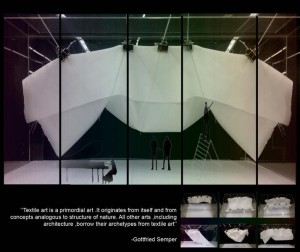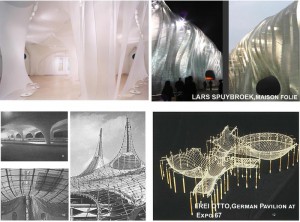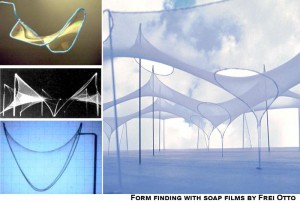Temporariness &Archicycle
|
”Textile art is a primordial art .It originates from itself and from concepts analogous to structure of nature. All other arts, including architecture, borrow their archetypes from textile art” -Gottfried Semper Why The introduction of concrete, steel and elevator allowed the building to develop taller and heavier. But just as Buckminster Fuller asked, “Do you know how much your house weighs?” While too conscious of house size, we gradually perceive architecture as permanent. But could it be smart and adaptive to various occasions? The question inevitably leads to the architecture discourse of temporariness and flexibility. The discourse of temporariness and flexibility could be traced back to the origin of architecture. Ancient Mongolian has a well-documented history of using tents for grazing. In Tropical House I ,Jean Prouve strengthened the idea by forming a prototype of easily assemble and transportable housing ,which suggests the possibility for buildings to be designed like boats or planes. Frei Otto devoted his whole career to seeking alternatives in which temporal architecture could perform lightly and efficiently based on corresponding material property and tectonic features. With advent of new material and digital technology , temporary architecture demonstrated great possibility. This thesis develops on the belief that architecture can mediate between different conditions in response to the constantly changing of national structures, natural disasters and soaring need of flexibility in scope of time and space. What ~My thesis attempts to utilize textile as a vehicle to explore architecture’s possibility of mediating between the changing conditions. Textile demonstrates its ability to mediate due to many of its inherent properties. While not fully explored, design language of textile from ornamental decorations, different cutting patterns to light structure system can enhance the attraction of textile construction. By adjusting the frame, the textile can be adapted to nearly any proportion and suits for new function. Its geometric flexibility and inherent expendability allows itself to be easily applied to the design of flexible architectural intervention and urban infrastructure. Just as Adolf Loos says , “An architect cannot build a house out of carpets. To invent the frame is the architect’s second task”. Textiles rely on frames to form various shape. Thus various methods for forming surface and relevant frame system will be explored. To achieve that, research contents will cover from small-scale material property, joinery to large -scale surface and structure system .Additionally , light, spatial atmosphere and mediation between programs and with surrounding environment will also be investigated. The selected site for testing the material will be a temporary market as it offers potential for creating a prototype for solving the paradox between land efficiency and cyclical use. How The design process will be conducted in two phases with different scaled models and drawings in assistance . MATERIAL RESEARCH PHASE : I will be carry out research into textile ,from existing cases ,expanse to mechanical properties of textile . Model-making and drawings may be needed. Then I will explore the specific joinery, structure and surface technique and test its effectiveness and architectural performance. Detailed model(from 1:1 to 1:20 ) will be needed. PROJECT PHASE: I will apply above research into the design of project in a specific site. A series of analytical diagrams of site context and small scale (1:100 to 1:500) models will be conducted to assist design and architecture problems such as light, comfort, spatial atmosphere, environmental effect and mediation between different programs will be explored. Bibliography: 1.Bahamon A. (2004). The magic of tents. Transforming Space, Loft Publucations, New York. 2.Otto F. & Rasch B. (1995). Finding Forms. Auf dem Weg zu einer Baukunst des Minimalen. Edition Axel Menges. Deutscher Werkbund Bayern. 3.Otto F. et al. (1982). Natural Constructions. Formen und Konstruktionen in Natur und Technik und ihre Prozesse ihrer Entstehung. DVA. Stuttgart. 4.Wolff C. (1996). The Art of Manipulating Fabric, Krause Publications, Wisconsin. 5.Drew P. (1979). Tensile Architecture, Westview Press, Colorado. 6.Koch K-M. (2004). Membrane Structures. Innovative Buildings with Film and Fabric. Prestel Verlag, Munich. 7.J.McMillan .” Reinventing the Bazaar : A Natural History of the Markets.” London, 2002
|




